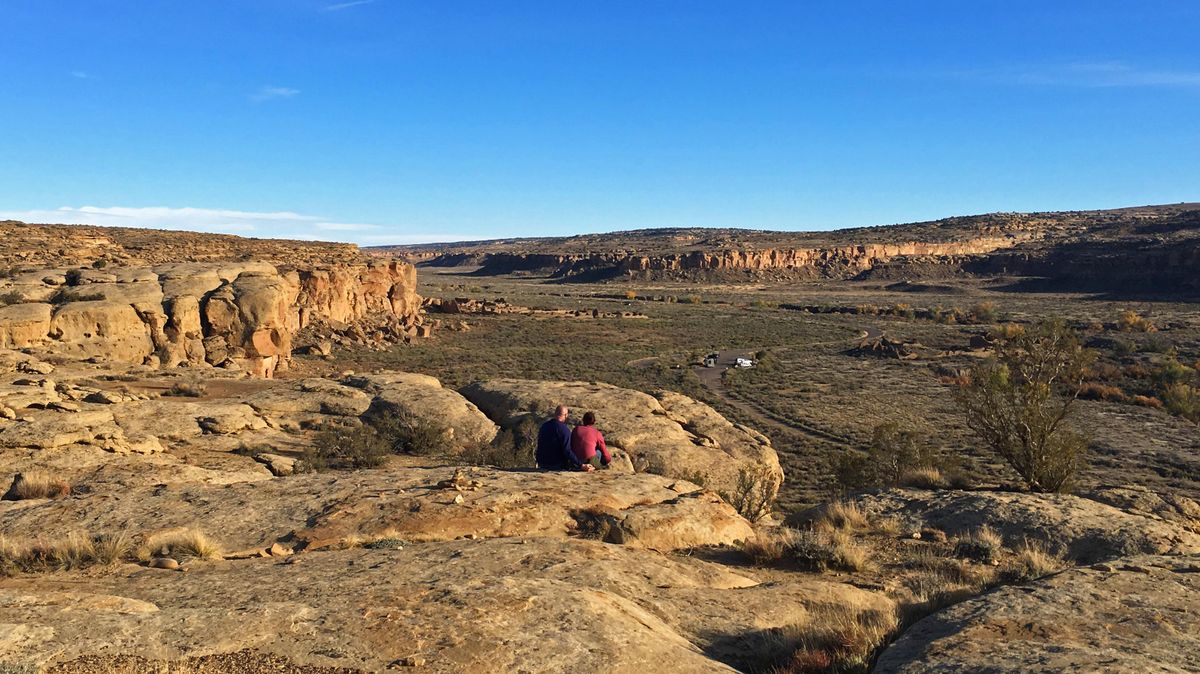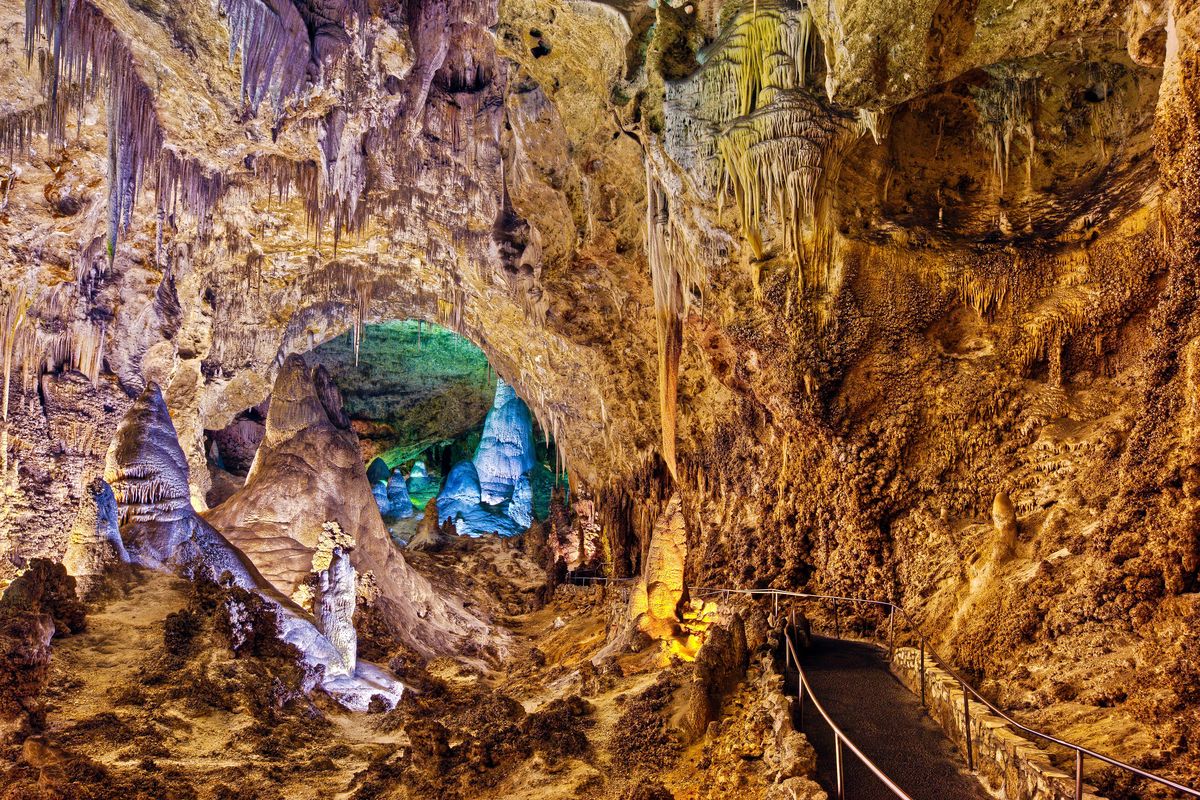Quiet wonder: New Mexico’s caverns, canyons and hot springs are best experienced at low volume

As we started our hike into Carlsbad Caverns, a ranger went over the instructions. The trail was steep and wet in places, he said, and then, “Once you’re inside, please use a whisper voice.”
Whisper voice? I’d never been to a national park where they asked me to whisper, but I immediately liked the idea.
And so we descended 750 vertical feet underground over 1.25 miles, daylight slowly receding into twilight and then finally, total darkness, the pathway and the caverns’ famous features artfully lit.
“This is so cool,” I whispered into my wife’s ear.
As we walked on, we caught each other’s eyes and silently gestured at the otherworldly features. We gaped at curtains, columns and stalactites, then whispered “oohs” and “ahhs,” our lips brushing each other’s cheeks with an intriguing intimacy.
It felt like our secret and yet we were surrounded by 50 or so other people doing the same thing as we ventured through the Big Room, the largest of the caves at Carlsbad.

That’s when it hit me: While I liked looking at the treasures of Carlsbad Caverns, what I truly loved about being there was the shared desire of visitors to preserve silence in a world full of sound and fury.
And throughout my travels in New Mexico, I’ve had that same feeling elsewhere in ancestral Pueblo ruins and hot springs scattered around the state where silence reigns and “whisper zones” are requested.
When you come to the Land of Enchantment, be prepared to practice the art of whispering.
Whispering as a policy
At Carlsbad Caverns in southeastern New Mexico, park officials instituted a whisper policy starting in the 1970s. That’s when rangers began allowing visitors to go on self-guided tours through the caves, said Bill Barley, supervising ranger at Carlsbad Caverns.
“It’s a better experience for everyone if they can go into the caverns and experience them in a natural state,” he said. “It’s just really, really quiet in there, and a normal human voice can carry over a quarter of a mile inside the caverns.”
So what exactly is a whisper?
Normal conversational speech registers at 65 decibels from approximately 1 meter away, said Sarah Duncan, an audiologist at the University of New Mexico in Albuquerque. Whispering is decidedly quieter, about 45 decibels.
The main thing that makes a whisper is how you use your vocal cords. When you speak normally, your vocal cords vibrate, amplifying sounds. When you whisper, you aren’t “activating the vocal cords,” Duncan said.
At many hot springs in New Mexico, whispering is requested because guests like to “Zen out and meditate” while they soak, said Jake Foerstner, general manager of Riverbend Hot Springs in Truth or Consequences.
“We started with, ‘Quiet voices, please,’ but the word ‘quiet’ is subjective,” he said. “Then we settled on whispering. People ended up loving it.”
When I visited Riverbend last winter, most guests followed the rules and barely even communicated, quietly murmuring as they soaked in pools overlooking the Rio Grande River.
If people do break the whispering policy, Riverbend encourages guests to use their cellphones to text the office so a staff member can quiet the offenders. Most of the time, that’s not necessary, Foerstner said.
“This is a place you come to relax. People like it because they want to sit quietly, watching the birds along the river, being a part of nature,” he said. “Their soul starts speaking to them as they’re soaking in the pools.”
A loss for words
A few man-made spaces in New Mexico have the power to quiet visitors.
The Dwan Light Sanctuary at United World College in Montezuma is one of those places. Created by an artist and a wealthy benefactor in 1996, the building uses prisms mounted in the roof and windows to cast spectacular spectrums of light.
“It’s a place that people do in fact whisper because it’s so striking,” said Carl-Martin Nelson, director of marketing and communications for UWC. “We ask people to take their shoes off when they come in. For some reason, that makes people naturally want to whisper.”
Ornately carved sandstone caves by artist Ra Paulette also have that capability at Origin at Rancho de San Juan, a retreat center near Ojo Caliente in what’s known as Georgia O’Keeffe country.
“People do whisper as they come into the caves because the space is so awesome,” said Jason Robnett, an instructor at Origin.
One of the caves is used for “sound baths,” a therapy that incorporates crystal singing bowls that produce resonant tones. Visitors lie down and let the sounds wash over them, which “feels almost like being inside a beating heart,” Robnett said. “It clears your mind (and) puts you into almost a dream state.”
While that might sound a bit New Age-y for some people, a site north of Santa Fe revered by an old-world religion also profoundly affects people. At Santuario de Chimayo, 300,000 Roman Catholics visit each year, many making the pilgrimage during Holy Week to pick up sacred dirt from the church grounds, said to be blessed with healing powers.
“They get this feeling of awe after they get here, and many people say they are struck silent,” said Bryanna Ellis, business manager for the church.
Whispers from the past
More than any other state, New Mexico whispers a connection to its indigenous people.
Dozens of historic ruins, some maintained as national monuments and parks, others scattered around the state’s distinctive landscape, tell the story of the ancestral Pueblo people. The most spellbinding of these places is Chaco Culture National Historical Park.
“When modern Pueblo people come to visit, they very much feel the spirits of their ancestors,” said Nathan Hatfield, chief of interpretation at Chaco. “And even for non-Pueblo people, it has a very strong spiritual feeling.”
I have to agree. My visit to Chaco in 2018 was filled with an unmistakable quiet energy as I hiked around the ruins set on the Colorado Plateau in the remote northwest corner of New Mexico.
Chaco has more than 3,000 structures scattered around its canyon country, the nights pitch black, the days filled with silence and beauty.
One early morning, I hiked the Pueblo Alto Trail high above the main Chaco complex. All alone, I climbed the steep trail to a striking 1,000-year-old ruin in the middle of nowhere.
Wait – was that the wind I heard or a whisper? Real or imagined, I was filled with quiet wonder.